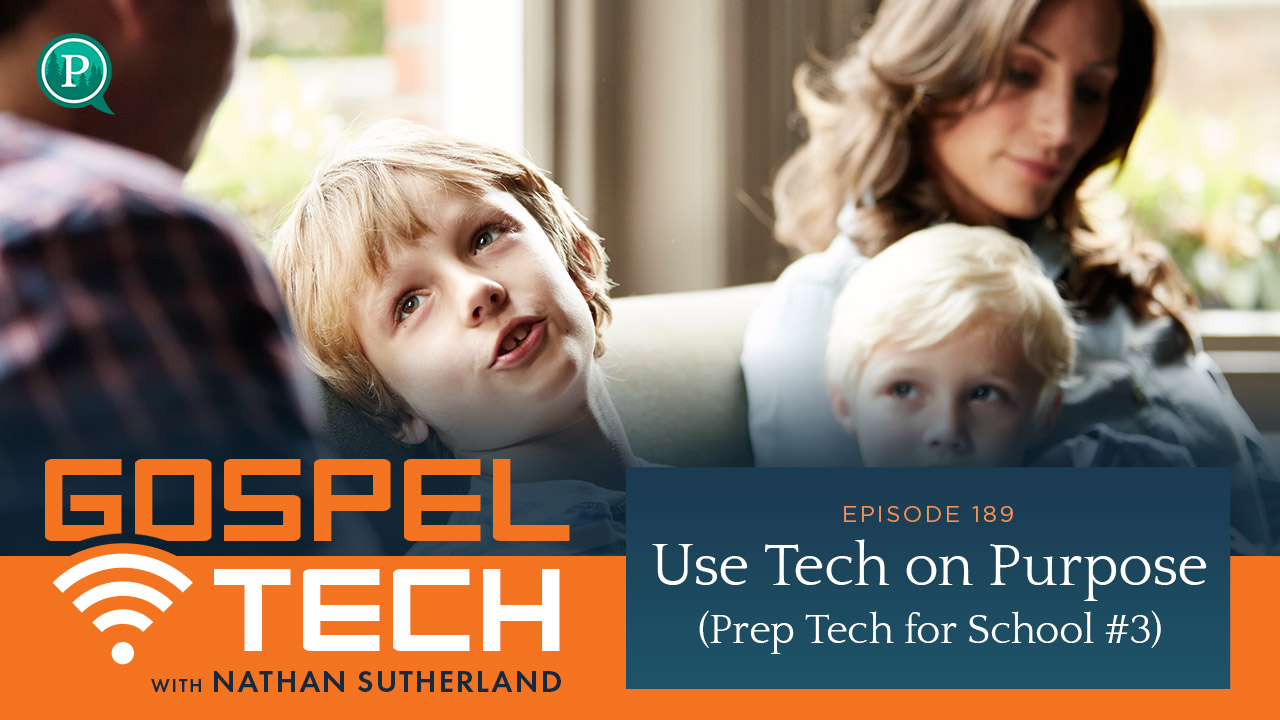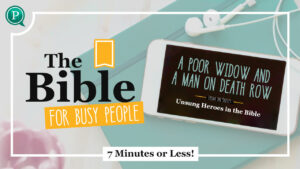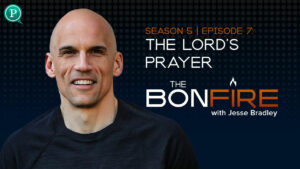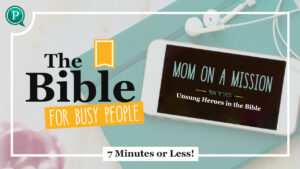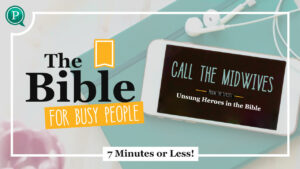There’s LOTS of stuff out there we could be doing. Many of those options are either morally neutral or even good (working out, time with friends, playing sports, serving at church).
The question is, what will get your time this week, when push comes to shove, what falls off the table first? Sometimes we’re choosing our tech because it makes us feel important or we simply can’t stand being alone with our thoughts. Sometimes we choose being busy or being still and abiding, and many of us choose our tech as the go-to way to fill the void.
Today we’re addressing five ways to use our tech on purpose and ensure our tech use is intentional as we head back to school.
Transcription:
Nathan Sutherland:
Heavenly Father, thank you for this opportunity to talk about tech and going back to school. I ask that as we talk about using tech on purpose and not for purpose, that you would give us wisdom and insight. That you’d open my mouth to speak clear words and that you would open our hearts to hear specifically what you’re saying to us about our kids and our technology. So that we can love you with our technology and not love our tech and ask you to come along with it. So I ask for just the simple grace to be able to share the Gospel clearly and for us all to be able to love you first and use our tech from that. In Jesus name, Amen.
Hello everyone and welcome to the Gospel Tech podcast. My name is Nathan Sutherland and this podcast is dedicated to helping families love God and use tech.
Today we are talking about our third part of our back to school, excuse me, “Prep Our Tech for School” series, which is Use Tech On Purpose. So first we talked about assessing our tech. We went through our tool tech and our drool tech. We then talked about a reset. How do we know if our tech is healthy? Then we talked about how do we build a hedge? That was last week’s. Please go check it out. We talked about how we build a hedge around our device, around our network, around our family.
And now we’re talking about how do we use our tech on purpose. Which is important, but it’s also a huge conversation. So I broke it into five simple little steps we can use. Five ways we can make sure that we’re using our tech on purpose, not for purpose. And we’ll dig into what that looks like. It applies to us as well as to our children, and it very much is a useful conversation to have as we head back into school. Because we’re having a shift in schedule. We’re having a different rhythm and cadence. And it’s going to bring up some ways that maybe our technology had snuck into our lives that now we’re not okay with, and we can talk about how we can fix. So that’s our conversation for today. And with no further ado, let’s get the conversation started.
Announcer:
Welcome To the Gospel Tech Podcast, a resource for parents who feel overwhelmed and outpaced as they raise healthy youth in a tech world. As an educator, parent and tech user, I want to equip parents with the tools, resources, and confidence they need to raise kids who love God and use tech.
Nathan Sutherland:
Thank you to everyone who’s helped make this podcast possible. Thank you for listening, for liking, for sharing and subscribing so you don’t miss any new content. And so that your friends and your family and your coworkers can have this content as well. Thank you for making this work possible. For those of you who have been listening, you know we just finished our annual fundraiser. It’s such a blessing to be donor supported. It allows me to go and speak at spots where people can’t necessarily cover the cost, but they still need the resource. And that’s true. At the end of this month, I’ve got a talk where I have the opportunity to give it because people are supporting that. So thank you for making that work. That’s incredible and encouragement, and it is helping other families hear this content about how they can love God and use tech. Today’s conversation, part three of our “Prepping Tech for School,” prepping our tech for going back to fall and this new season of being indoors.
If you’re in the Northwest, it has begun. It’s already started. I know around the country we have lots of intense weather, but here in the Northwest we’re beginning our hunker down season. We’ll have a couple more sunny days, but it’s going to be 50 and raining for like seven months at this point. So what are we doing with our technology? Well, we’re going to use our tech on purpose, not for purpose. The idea there being I want to use tech because I love God, not because I’m looking for hope. So if I use it on purpose, I’m going to technology because I have a need and it’s going to fit that need. Great. Versus, “Man, I wish I felt something. And now I’m going to technology to try to fill the void.” So that’s what I’m trying to say there on this using on purpose.
The idea though is, as we head into fall, we have lots of things we could be doing. Even lots of great things. We could be sharing the Gospel on the internet. We could be reaching out and inviting friends to things. We could be serving in our church or in our local community. We could be exercising or playing sports. We could be creating new content. We could. But we have a finite amount of time and we’ve been called to a specific purpose. This is again Ephesians 2:10, this idea that we’ve been, or 2:1-10 in this case. We’ve been saved by grace, by faith, for good works that God prepared beforehand for us to do. So that’s our question. If we’ve been redeemed and our time’s no longer our own, what do we do? Let’s look at this.
The first, well, there’s five encouragements. First of the five encouragements on what should we do with our time is, we’re going to pick tech that moves at the pace of real life.
This is a John Mark Comer encouragement coming out of his book, the Relentless Elimination of Hurry. Excuse me. Oh my goodness, I messed up his title. It’s the Ruthless Elimination of Hurry, but “Relentless” isn’t bad. But that’s not the quote. The quote is Ruthless Elimination of Hurry that he’s referencing. And this idea is, we want to pick tech that helps us be present, that helps us move at the pace of real life. And by that I simply mean and to use his encouragement phrasing, he says, “We want to use tech that doesn’t make our bodies move faster than our souls.” There’s technology we use that’s excellent at helping us do what God’s called us to do. And then there’s technology we use that simply escapes it. And what we’re trying to look for here is technology that improves our ability to be faithful but doesn’t distract us from it.
I’ll use a very simple example in my life. This would be email. Email is a phenomenal tool for my work. And yet I can’t have it on my phone because I’m checking it all the time. And yes, it’s good work and all of the work I’m checking on my Gospel Tech email account is Gospel Tech-related. I want to know about the upcoming talks and about that new project we have going on and where that other thing is in transition. There’s lots of dreaming and faithful hard work that’s going on. And yet I probably shouldn’t be checking it when my kids are going to bed and they all went into their rooms and I’m on the staircase. I’m like, “I could check it real quick.” I shouldn’t be doing that. And I probably shouldn’t be checking it while I’m waiting for my family to get into the car and while I’m sitting in a line and filling in all those little gaps.
That’s not good. It’s not good for my heart. It’s not good for my brain. It’s certainly not good for modeling tech for my kids. And yet I had a hard time just saying no. So what do I have to do? I have to remove it. It’s not a tech that helps me operate at the pace of real life. So what do I do? I check it on my laptop during work hours on certain days. I have to have really specific boundaries with my email. But this is an example. Let’s use our tech that helps us be intentionally paced. Slow tech is usually good at that. And if you need more encouragement on that, please read the Ruthless Elimination of Hurry or get it on Audible/ or I don’t know, find a used copy somewhere for $2.
But it’s not a hard read. It’s a really good read. I don’t reread a lot of books and that is on my reread list. It’s a solid encouragement. It’s something as we head into fall, we need to think about. What tech is causing us to be frenetic in our pace and is stopping us from being able to be present and intentional with our pace? So that’s our first piece. There’s lots of great encouragements in the book, by the way. If you don’t know what it looks like to even step away, he’ll have you do annoying things that, they’re not spiritual practices or biblical per se. They’re just good, what would you say? They expose our need for pace just because it’s fast. So things like, “Drive only the speed limit for a day.” Try it. I dare you. If it says 55, go 55 in the slow lane on purpose. Set your cruise control, because it’s going to drive you crazy. You’re going to feel like a bad American. You’re going to feel like a terrible person. It is going to wreck you. Try it.
“Pick the long line at a grocery store,” is another one he gives. And these, again, they’re not spiritual things. They’re talking about pace of life, that we’ve amped ourselves up so much and we’re used to having things so fast that sometimes we need to take a step back to just realize how hungry our souls are for quiet and slow. And the reason we feel uncomfortable when we try to do a quiet time isn’t because God isn’t needing us. It’s because we’ve built ourselves up to a pace that we demand God to meet us on our terms. And that’s not how God works. He’s in the slow and the quiet. And we want to make sure that we make space for that, too.
The second thing we can do is we prep our tech for fall. To use tech on purpose is use only the tech that helps us. This is a Rosaria Butterfield concept. And I am using it a bit out of the context. Her book is not about technology. She’s talking about the Gospel coming with a house key, but there’s this throwaway bit about how she doesn’t post her family gatherings.
So the premise of it is she was saved amazingly and radically through community with Christ’s followers when she was an active rebel living her life. So please read her testimony in her book. The entire thing is solid. Read it front to back. But there is this piece when she’s like, “Well, we offer these weekend gatherings or weeknight gatherings, excuse me, all week. We always host just open meals.” Not the point of this conversation. Just know that that’s the premise. And then she says, “We don’t post these on social media. We’re not putting them on Facebook or Instagram. And the idea being we don’t want to ruin this intimacy and the sacredness of sharing the Gospel and sharing meals with these people and make it a thing that maybe just might be become distracting at best.”
We might be trying to glorify God, but this might be taking the tone. So she’s like, “That doesn’t help our mission, therefore we don’t use it.” If your mission is helped by posting those kinds of things, then please do it. But the point is, we’re going to use tech that fits the need. And in her world, she’s like, “We don’t use social media, except we use this Nextdoor app.” Or whatever app might be good for you. But they post regularly. If something bad in the neighborhood happens, they post to it. “Hey, we’re praying at our house.” If there’s a storm, they say, “Hey, hot cocoa and food at our house. Every single night of the week, there’s an open meal. Come join us. Let us know if you can make it so we can make enough.” Right? That’s a really great way to use social media for Gospel purpose in a way that fits with real life, that adds to the value of your life.
I’m using a form of social media right now through podcasts. And where we post this podcast itself, we’ll use Facebook and Instagram. But I’m not on it every day. Actually another example, I don’t have Instagram or Facebook on my phone. I find them too distracting and I start going through life thinking, “Oh,” instead of “I’m so present.”
We went to the beach this last weekend. Instead of saying, “I’m so present in this moment with my kids,” I have thoughts of like, “This would travel well on the internet.” I don’t want to do that. So I’ll post something about my kids, but it’ll be intentional. It’s not why I took the picture. I just happened to have a picture of this thing we did, and now I’ll post it in a really specific time and place. So that’s what we’re talking about. The second one, the first is we want to choose tech that is slow to use on purpose. Because slow demands that we use it for just what we need, not just because it moves fast and it makes me feel good.
And the second is, I want to make sure that it fits a need for my family. Rosaria Butterfield’s encouragement of, “We just use this social media because it helps our mission for what God’s called us to and where he has placed us.” I love that. Also, Gospel Comes With a House Key is a fantastic book. Please read it. It’s challenging across the board on everything from how do we handle conversations about gender and sexuality to how do we share the Gospel with people in our lives that are messy and broken, and we’re not at all equipped to deal with their problems. She really graciously and, the word “furtively,” but that’s not the word I want… “Intentionally.” She’s going to push on you, but not in a way that’s going to make you feel shameful.
I really encourage you, there’s some books out there that are like, “What? You haven’t died as a martyr for Christ yet? You haven’t lived.” This isn’t one of those books. Instead, it makes you want to look more like Jesus in your daily life, so please do that.
The third, then, way we can prep our tech for this fall by using our tech on purpose is use, or excuse me, put the tech in places that fit your family’s values and focus. This comes from Andy Crouch’s, Tech-Wise Family, another phenomenal book. Please check it out. And he uses the phrase that we need to put tech in its proper place. We don’t avoid tech, but we make sure that it fits what we want out of our family. This was the book that inspired Anna and I to take a season away from having a television. We don’t have a TV in our house. Our kids still watch shows. We just watch it on laptops. Because when we walk into our living room, we would stare at this giant black box. And I know there are TVs that have pictures on them, and I get that.
We weighed those options and those costs and we said, “Hey, you know what? Right now we’re just going to have a laptop. Our kids can watch it. We then can throw it in a drawer and close the drawer, and we don’t have to look at it anymore.” And for us that fits great. We bring the laptop on a trip. We did a road trip, again, to the beach. And our kids watched some shows. We had some DVDs, Planet Earth from BBC, delightful. It’s the old one, not the super-scary new one that just focuses on the planet falling apart. But they’re the wonder and the amazement. It’s beautiful. So our kids watched that. It was super cool. So it was useful. It’s functional. They still watch TV, but it’s not a television.
And that was a direct outcome of this idea of, how do we pick tech that fits what we need? Maybe for you, it means the TV is going to be in a specific room in the house. You have an entertainment room? Cool. Maybe for you it’s not TV at all. It’s related to your smartphones, or your tablets, or your e-readers, or your gaming devices. Or whatever other technology you might be processing in real time right now. That’s what you want to do is, “All right, what fits our family’s values as a family? Just what technology are we bringing in?”
We’re not talking season of life yet. We’ll get to that, but this is just, “What tech fits our family in this season?” And then run with it. As you head to the fall, you may realize, “You know what we brought in some summer tech that doesn’t make sense with these new rhythms.” Cool. There might be actually a shift the other way. Go, “You know what? As we lock down, as we hunker into our rain bunkers, what can we do to make this fun? And we’re going to bring in movie night. We’re going to bring in more technology than we had during the summer.”
And that’s awesome too. Just make sure it’s intentional for your rhythms, for your family, and your commitments. What fits around your sports and your school and your family worship and your church involvement and generally being on mission? You want to make sure that that’s the tech you’ve got for your family. Another side note from the Tech-Wise Family. He put an emphasis on putting music at the center of his family. So they put in instruments. I love that idea. I’m not super musical, but I want that for my children. So whatever it is for your family, there are opportunities to emphasize with the space you have. Our family, we have a Lego space. It probably would be a TV room in another setting. But at this season of life, this is our Lego space.
Does it get crazy? Yes. Does it drive us bonkers with all the pieces, all the places? Yeah. It’s not a perfect Lego space. You’ll notice I’ve never posted any pictures of that space. It’s not really Instagram-worthy. It’s just a space for the kids to make and mess up and mash their Legos together. And they currently enjoy it a lot. And it’s a space we can say, “Hey, go play in the Lego room.”
We have a Lego room. Cool. That was intentional though. And it’s not because it’s perfect. It’s not pretty. It’s not organized. But it is intentional. So that’s what we’re talking about with space.
The fourth then is, choose safe tech. We talked about this previously. But before you give your child any technology this fall. As we head into winter and Christmas is coming, make sure that this tech is safe. The safest tech is going to be tech that doesn’t have internet. It’s not going to have apps. It’s going to have accountability. And it’s going to be tool tech, not drool tech. It’s going to help you create, not help you consume. So something like a 3-D printer? That’s pretty safe tech. Maybe it’s not a good fit for your family, but it’s safe. You’re not going to make a lot of mistakes using your 3-D printer.
But what about the tablet that feeds the 3-D printer all those designs? Well now, that is probably going to have at least some drool tech elements. It probably has the internet. It probably has apps, and I don’t know if there’s any accountability installed on it yet. Because I don’t know the type of tablet you’ve got or what your family’s currently running on their network in their devices. But you should know it’s not intrinsically the safest tech. So if you’re going and saying, “Hey, I want this 3-D printer, perfect tool tech, but it only works with this iPhone or this tablet or this computing device. Then I need to make sure that that’s going to be safe for my family in this season.
Doesn’t mean don’t have drool tech or don’t have the internet. It just means that’s our safest tech. Make sure the tech you’re giving your kid when your child asks for an egg. Says “Mom or Dad, I want this good technology.” Awesome. Give them that good tech. What happens if you realize the tech you thought was good no longer is? Because of season, because of choices, because of community, because of any number of reasons it’s perfectly reasonable to remove that technology and replace it with something that is healthy. I just had a conversation with a dad this week who said, “Hey, we gave my child a smartphone and it’s not working out. We are trying to then backtrack to something like a gab phone, and it’s not doing what we need it to do. What should we do?”
I put out a short video on this, but I’ll just say here, something like a Bark Phone can be an awesome fit for this. You gave the smartphone because your child had earned trust. It has accountability on it. You’ve done the little steps up to that point and they have earned this opportunity for this independence. And they’ve equally just unearned said independence. They’ve proven that it’s not a good fit right now. All right, what do I do? Something like a Bark Phone is a great option. Where you can take a phone and then limit it to where your child is currently healthy and well. So you say, “Hey, during these hours…” Or only using this app or these apps. It allows you a lot of parental support, a lot of relational communication. And the Bark Phone comes hard baked in with bark on the device. So it’s not able to be booted in safe mode and you can get around the accountability that comes with that.
Again, I love the way Bark does their accountability. Because it’s not reading your child’s digital diary. It’s you getting updates if something goes awry, so you can be the first person to intervene and intercede to love your child well in the problems that happen online.
So that’s just an example of using safe tech and choosing tech that’s a good fit. In this family’s case, it was a great fit. By the way, the Bark Phone’s 49 bucks a month. That includes the service that your child, the cell service, it’s going to be Verizon. It’s going to be a separate bill. And it includes the accountability software, which is normally 14 bucks a month. That’s just baked in there, and it includes the phone. So 49, and it’s a good-looking phone. I would say it’s a little more updated than a Gab Phone, which is a nice step. Gab Phones are an awesome start for a safe first phone, when your kid turns 14, 15. And wants that first device or needs something maybe even earlier because they have sports or communication or separate homes, all that stuff.
Gab’s awesome. And the next awesome step would be a Bark rather than a full-fledged smartphone that can be really tricky sometimes to lock down and to keep accountable.
All right, so we have our first three. We’re going to go slow. We’re going to fit a need. We’re going to keep it in its proper place. So we have Ruthless Elimination of Hurry, Gospel Comes With a House Key, Tech-Wise Family. Then we have Choose Safe Tech. It’s a Gospel Tech original. Sorry, I don’t have any references for that. But that is your kind of standard basis for if you want to choose safe tech.
And finally, we’re going to use tech that helps us be faithful and produces good fruit. So faithful, this is the tech trust side. So look at your child and say, “Are they being faithful in the little things?” Does my child, those who are faithful in little, be faithful with much? How can we show that this intense amount of freedom that I’m giving my child with this access to technology they’re gaining? Are they being faithful in little things? Little things like, how are they treating their siblings? Little things like, how are they listening when I ask them to do something?
I want to draw a line here because sometimes we’re tempted to use technology as a reward. “If you are good, then you get this thing that I don’t like.” “Well, I don’t like this tech much, but if you do what I want, then I’ll give you this.” That’s not what we’re doing. We’re picking the tech that’s a good fit for our family. It’s safe. It fits our family’s season of life. It fits our family’s… Our desires and our mission and our priorities. We’re using tech on purpose and then we’re saying, “Hey, these are our boundaries for it.”
So you can use this technology in this window. You don’t have to earn it. It’s just we’re using this technology, but this is when we use it. For this much time on these particular days in these particular ways. Great. Then you can lose that. And you don’t lose it because, “I’m mad at you, child.” Son or daughter of mine, I’m not removing this because, “This’ll teach you.” Instead, it’s, “This is unsafe for you or someone else. It’s just not a good choice right now. So this tech goes away and we’re going to replace it with something else. I’m not mad at you. This isn’t punishment.”
And my concern in using the carrot and stick of the technology of like, “Well, if you do bad, then I’ll take this away from you so that you can really suffer,” is it puts technology in an incorrect spot as like the pinnacle of goodness. And now your child is constantly trying to get back to the place where that technology is. “Let me have it.” And it becomes this kind of reward in their brain that it shouldn’t be.
Technology should be part of how we live our lives. And if video games are going to be part of your life, then let them be part of your life. If they’re unsafe, then acknowledge they’re unsafe. They’re not going away because you’re mad, they’re going away because they’re a bad choice right now. They don’t fit one of these other things. They don’t help you be slow and present. They don’t fit a need. They don’t match your family’s values and priorities. They’re not safe. Or in this case, it’s because of a lack of faithfulness in another area. “Hey, I can’t trust that you’re making good choices on that technology, or with that show, or with that music, or with that social media platform. Because I can’t trust you to do it in real life. Why in the world would you make better choices digitally if you can’t make them analog?”
Think about that. When’s the last time someone was nicer to you over the internet than they were in person? It doesn’t really happen very often. Most of the time we’re awesome in person and we say things in emails and in social media posts that we would never say face-to-face. So that’s what we’re working on as the faithful piece. Are they being faithful in their little things? I would say it comes down to relationships, familial trust, and communication and their use of money. You can add sleep to that. But there’s lots of other things you could look at. But those are the biblical ones that we can say, “Hey, there’s a foundational statement where we are supposed to be faithful in our ‘yes’ and our ‘no.’ We’re supposed to be faithful in our obedience to your parents. We’re supposed to be faithful in how we handle our money.”
And it’s exposing our hearts. And maybe the things they say, the words expose our hearts. We could add that one too. So that’s our faithful. And then the fruit. I’m not being facetious when I say this. Your technology and the technology your children use should make them look more like Jesus. They should be more love and joy and peace and patience and kindness and goodness and gentleness and faithfulness when they use that tech.
And if they use that tech and they look more like Jesus, please give them more of that tech. That’s incredible. And if it doesn’t, adjust. Remove it and replace it with something else. And again, the reason I say I’m not being facetious. Some people hear that and they roll their eyes, but I really believe this is the standard. I’ll use the examples I’ve already said, but I’ll tie them in with this. The reason our family doesn’t have a TV in our house right now is because it was a distraction. And it was regularly becoming a point of contest in our family where our kids would walk in a room, see a TV and be like, “Hey, why aren’t we doing that right now?”
I don’t love the prompt. It’s not helping our family. It’s not something we need. We don’t need that amount of space. We’re not hosting massive Super Bowl parties. That was part of the conversation. “But what if we want to host a Super Bowl party?” Which we’ve never done, but what if we wanted to? Well, we’re I think two and a half years into it, we have yet to host a Super Bowl party. In addition to the previous 14-and-a-half years of marriage in which we never hosted a Super Bowl party. So for our family, we put this away to stop some of the battle that was going on around this technology that we were seeing. It was causing an issue on the fruit of simply having it be visible.
We’ve seen that again with shows, a positive. Our children, I’ve said it before, love Wild Kratts. And what does that do? It drives them to watching an hour-long episode of BBC’s Planet Earth. This isn’t because my children are magical or amazing. It’s because they love learning about nature and science and little things that expose the wonder and beauty of creation is awesome. So BBC’s Planet Earth was a great fit for them. Actually while we were at the beach, grandparents said, “Oh, we want to buy you guys a book.” And Owen picked one on Animals in the Ocean and Henry picked one on Animals on Land. Because that’s where their brains are. That’s what fascinates them. So I want to give them technology that allows that to happen. I want to encourage that Wild Kratts right now is part of that. Cool. And the BBC Planet Earth is part of that. Great. But we’re engaging it through a laptop instead of through a screen.
Because the screen posed a little bit of an issue. It kind of drew them away into distraction more than into wonder. And that’s what we’re talking about. So when your kid plays a game, have them come away more loving and connected and amazing. And if they play a game and they aren’t that, and they have envy and jealousy. And they have fear of missing out and whatever that might be. This is my story with video games. Well, video games are expendable at that point. Maybe it’s going to be board games, maybe it’s going to be sports, maybe it’s going to be something else. But that idea of making sure you’re looking at the faithfulness of this technology, excuse me, our faithfulness when using this technology. Are we faithful in the little things? And the fruit. What is it producing when we go to it? If it produces something bad… A parent who came with a smartphone is like, “This isn’t good anymore.” Used to be good. No longer good, remove and replace.
The biblical example of this is, we’re going to cut off and gouge out anything that causes us to sin. If it causes us to put our hope in it, if it causes us to rely on it to be okay, then we want to remove that thing. And replace it with something that helps us be more of who God has called us to be. And we’re going to know that by the fruit we’re producing. I hope this is encouraging at this point, and this Prep Tech for Back to School, Prep Tech for Fall series. You now know how to assess your tech. Both what type of tech it is, if it’s tool or drool, and whether it’s healthy with a reset. You know how to build a hedge around your devices, your networks, your family.
And you know how to use tech on purpose, not for purpose. Because tech that is moving slow, that fits a need, that matches your family’s expectations, that’s safe tech, and that produces good fruit? And is being used faithfully in the little things and then as an extension of that faithfulness into the digital world? That’s going to be healthy tech. It’s going to be tech you use on purpose, not for purpose.
And I’m encouraged now for you to go out into the world. Please, if these help you, share them with somebody. Find someone who is asking big questions about their technology and help them work through this conversation, both personally and then with these resources. Share it with your coworkers, with your people at church, and your co-op, at your school… And may they be encouraged by this as well. Continue to pray for Gospel Tech, that this ministry would be used by God to encourage families. And join us next week. Because we’re going to continue this conversation about how we can love God and use tech.
If you have any questions about this, you’re welcome to send them to me, [email protected]. I would love to be a resource for you. And you can find us on Instagram and Facebook at Love God, Use Tech. So thanks for being in this conversation. I hope it was encouraging for you. And please, as I mentioned, please join us next week as we continue this conversation about how we can love God and use tech.

